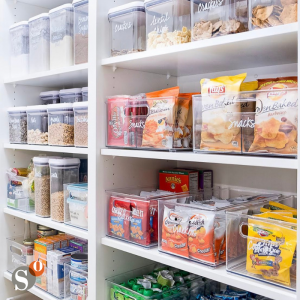An organized kitchen leads to easier meal prep, less stressful dinner time, and better health. Yes, it’s true. Research has shown that a cluttered kitchen leads to more snacking and potential weight gain. Did I get your attention? Does this make you eager to find some tips for decluttering?
Pandemic Pile Up aka Kitchen Clutter
 As the hub of the house most of our daily life ends up in the kitchen – mail gets dropped on the counter, kids jackets and backpacks end up on the table, school papers and permission slips pile up. Add food, small appliances, and other miscellaneous stuff and it’s no wonder the kitchen becomes cluttered. We’ve also noticed an on-going trend toward anxious shopping. Anxious shopping can be the fear of running out of food and paper products we experienced at the height of the pandemic, or general online shopping out of boredom. We’ve seen lots of extra kitchen gadgets and other purchases piling up in the kitchen.
As the hub of the house most of our daily life ends up in the kitchen – mail gets dropped on the counter, kids jackets and backpacks end up on the table, school papers and permission slips pile up. Add food, small appliances, and other miscellaneous stuff and it’s no wonder the kitchen becomes cluttered. We’ve also noticed an on-going trend toward anxious shopping. Anxious shopping can be the fear of running out of food and paper products we experienced at the height of the pandemic, or general online shopping out of boredom. We’ve seen lots of extra kitchen gadgets and other purchases piling up in the kitchen.
“A cluttered kitchen is challenging to clean and frustrating for the family.”
To address these challenges as part of our tips for decluttering, we start by clearing the counters. All paper is sorted by what is current and needs attention vs. what can be tossed. Corral it all in one place and set up a daily paper/mail processing routine in the kitchen (or ideally a nearby area with recycling bins) to reduce the pile-up. If you are buying back stock (the organizing term for “extra”) of food and paper products, figure out where it will live for easy long term access. It may be time for you to create an overflow pantry or Costco closet in the garage or basement. Before heading to the grocery store or logging in to Instacart, make it a habit to restock your main pantry from your overflow pantry first. This exercise will save you time and money by identifying what you really need.
Overstuffed Cabinets
 Cluttered counters are usually a sign that the cabinets are overstuffed and dysfunctional. Putting items away is impossible or simply just too frustrating so they end up living on the counter. This is especially true if you are adding extra items to your shopping cart “just in case.”
Cluttered counters are usually a sign that the cabinets are overstuffed and dysfunctional. Putting items away is impossible or simply just too frustrating so they end up living on the counter. This is especially true if you are adding extra items to your shopping cart “just in case.”
To fix this we suggest taking everything out of the cabinets and drawers and grouping like-items. This process will quickly show where you have multiples of certain items and can pare down (or move elsewhere). Set aside duplicate items and discard things that are no longer functional. Common examples are reusable water bottles that are missing the straws, or plastic food storage containers without matching lids. This is a quick and easy way to reduce what you have and make space in the cabinets. Do this exercise for all categories (storage, cookie sheets, cutting boards, etc) to identify things that no longer serve you. Segregate these items for donation or trash.
Remember the 80/20 rule – we use 20% of what we have 80% of the time. During decluttering, we find small appliances and other cooking tools that are rarely used but take up valuable space. You may not be ready to let them go, and so we suggest relocating these less frequently used items to another storage area (an overflow pantry or Costco closet) in the home. This frees up space for the items you do use on a daily basis.
Zone Out
 Creating zones also helps to keep control. For example, make it easy for the baker by storing all baking supplies in one cabinet and helping them stay organized. Assigning homes (and labeling the shelves, bins or baskets) is another way to make sure things don’t end up on the counter, easily accessible but also causing clutter.
Creating zones also helps to keep control. For example, make it easy for the baker by storing all baking supplies in one cabinet and helping them stay organized. Assigning homes (and labeling the shelves, bins or baskets) is another way to make sure things don’t end up on the counter, easily accessible but also causing clutter.
These are just a few tips for decluttering to consider as you regain control of your kitchen this fall.
If this feels overwhelming or daunting for you, we’re here to help! Contact the team at Smartly Organized and we’ll ensure a smooth decluttering process from start to finish.


